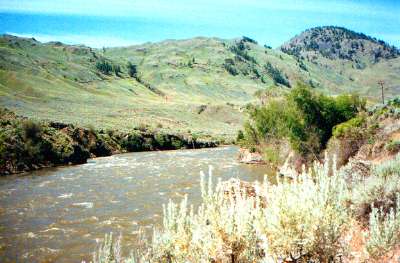
![]()

Somewhere along this stretch of the Similkameen River, between Nighthawk and Shanker's Bend stood the haphazard collection of tents and shacks they called, Okanogan City.
This old mining camp on the Similkameen River claimed a shifting population of more than 2,000 placer miners in 1860. The exact location of the original site of the camp has never been determined.
Like most temporary placer mining camps, it was primarily a tent town that lasted only a few hectic months. After the rush subsided however, there were few permanent remains left to indicate where it had once stood.
Strangely, although this historic placer camp was the greatest of all of the placer camps in early Washington history, the original site of Okanogan City has never been found. Undoubtedly the site still lies somewhere along the north side of the river, truly a vanished camp from yesteryear.

Although the rail no longer exists, the old railroad right of way and the tunnel through Shanker's Bend remains as a testament to James J. Hill, the "Empire Builder" of the Great Northern. When Hill passed away in 1916, he left an estate of $53 million
The stampede was triggered off in October, 1859, when soldiers of the 9th infantry guarding the American commission panned for gold from the Similkameen River at Rich Bar, about one half mile upstream from the later site of Enloe Dam.
Rich Bar is now submerged beneath Enloe’s backwater. Its exact location is uncertain, but there have been evidence the bar was just downstream from Shanker's Bend.

Looking eastward down the Simikameen River in the direction of Shanker's Bend, with Rich Bar in the foreground. Possibly near by, somewhere hidden under the rolling hills, visible in this photo, lies the undiscovered long sought after "Rich Bar Vein."
Over 31,000 ounces, a total of more than 2,500 pounds troy, came from this locality, mainly from Rich Bar itself. It was an astonishing find but some of those early prospectors knew that the origin of the gold lay very close by.
By the late 1890s, serious attempts to locate the mother load were being made. These prospectors, most of them old hard rock miners, knew that there was a vein or series of veins just upriver from Rich Bar, and these veins had been the origin of the massive amounts of bonanza placer gold that had been recovered by earlier miners.
The old theory that it had broken away from a hidden vein and had been carried down river eons ago and had lodged just downstream of Rich Bar is generally accepted.
![]()
